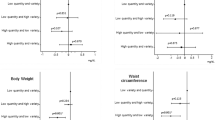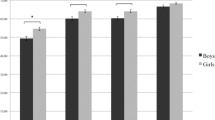Abstract
Background/objectives
We previously demonstrated that fruit and vegetable consumption, was associated with less weight gain over 6 years in young women for all body mass index (BMI) categories. This study evaluated the relationship between diet quality and 6-year weight change, in Australian women initially in the healthy weight range (≥18.5 BMI <25 kg/m2) at baseline.
Subjects/methods
A total of 4083 young women (27–31 years) in the healthy weight range (≥18.5 BMI <25 kg/m2) enroled in the Australian Longitudinal study on Women’s Health (ALSWH) were analysed. Diet quality was measured by the Australian Recommended Food Score (ARFS) and the Fruit and Vegetable Index (FAVI) using dietary data derived from a validated food frequency questionnaire. Weight change was calculated as the difference between baseline and 6-year follow-up weight (kg). Multiple linear regression models were used to analyse the association between baseline ARFS and FAVI and 6-year weight change.
Results
At baseline, mean diet quality was low for both indices [ARFS (maximum 72) = 29.9 and FAVI (maximum 333) = 94.2] and women gained 3.7 kg of weight during 6 years of follow-up. Regression modelling revealed that every one point increase over 6 years in either the ARFS or FAVI score was associated with statistically significantly less weight gain over 6 years, although the amount was small (33 and 12 g, respectively).
Conclusions
Higher diet quality predicts lower prospective weight gain in young women however, further research is needed over a longer follow-up period and in diverse population groups.
This is a preview of subscription content, access via your institution
Access options
Subscribe to this journal
Receive 12 print issues and online access
$259.00 per year
only $21.58 per issue
Buy this article
- Purchase on Springer Link
- Instant access to full article PDF
Prices may be subject to local taxes which are calculated during checkout

Similar content being viewed by others
References
Kyu HH, Abate D, Abate KH, Abay SM, Abbafati C, Abbasi N, et al. Global, regional, and national disability-adjusted life-years (DALYs) for 359 diseases and injuries and healthy life expectancy (HALE) for 195 countries and territories, 1990–2017: a systematic analysis for the Global Burden of Disease Study 2017. Lancet. 2018;392:1859–922.
Stanaway JD, Afshin A, Gakidou E, Lim SS, Abate D, Abate KH, et al. Global, regional, and national comparative risk assessment of 84 behavioural, environmental and occupational, and metabolic risks or clusters of risks for 195 countries and territories, 1990–2017: a systematic analysis for the Global Burden of Disease Study 2017. Lancet. 2018;392:1923–94.
World Health Organization (WHO). Overweight and obesity: key facts. Geneva, Switzerland World Health Organization (WHO); 2018.
Australian Bureau of Statistics (ABS). Australian Health Survey. National Health Survey: first results. Key Findings 2017–2018. Canberra, Australia Australian Bureau of Statistics (ABS); 2018.
Hiza HA, Casavale KO, Guenther PM, Davis CA. Diet quality of Americans differs by age, sex, race/ethnicity, income, and education level. J Acad Nutr Diet. 2013;113:297–306.
Allman-Farinelli MA, Chey T, Bauman AE, Gill T, James WPT. Age, period and birth cohort effects on prevalence of overweight and obesity in Australian adults from 1990 to 2000. Eur J Clin Nutr. 2007;62:898.
Pendergast FJ, Livingstone KM, Worsley A, McNaughton SA. Examining the correlates of meal skipping in Australian young adults. Nutr J. 2019;18:24.
Pereira MA, Kartashov AI, Ebbeling CB, Van Horn L, Slattery ML, Jacobs DR Jr., et al. Fast-food habits, weight gain, and insulin resistance (the CARDIA study): 15-year prospective analysis. Lancet. 2005;365:36–42.
Watts AW, Mason SM, Loth K, Larson N, Neumark-Sztainer D. Socioeconomic differences in overweight and weight-related behaviors across adolescence and young adulthood: 10-year longitudinal findings from Project EAT. Preventive Med. 2016;87:194–9.
Mendoza JA, Drewnowski A, Christakis DA. Dietary energy density is associated with obesity and the metabolic syndrome in U.S. adults. Diabetes Care. 2007;30:974.
Ledikwe JH, Blanck HM, Kettel Khan L, Serdula MK, Seymour JD, Tohill BC, et al. Dietary energy density is associated with energy intake and weight status in US adults. Am J Clin Nutr. 2006;83:1362–8.
Norman JE, Bild D, Lewis CE, Liu K, West DS. The impact of weight change on cardiovascular disease risk factors in young black and white adults: the CARDIA study. Int J Obes. 2003;27:369.
Adamson L, Brown W, Byles J, Chojenta C, Dobson A, Fitzgerald D, et al. Women’s weight: findings from the Australian longitudinal study on women’s health. The University of Newcastle, The University of Queensland; 2007.
Pengpid S, Peltzer K. Associations between behavioural risk factors and overweight and obesity among adults in population-based samples from 31 countries. Obes Res Clin Pr. 2017;11:158–66.
McCrory MA, Suen VM, Roberts SB. Biobehavioral influences on energy intake and adult weight gain. J Nutr. 2002;132:3830s–4s.
Aljadani H, Patterson A, Sibbritt D, Collins CE. Diet quality and weight change in adults over time: a systematic review of cohort studies. Curr Nutr Rep. 2015;4:88–101.
Aljadani H, Patterson A, Sibbritt D, Collins C. The association between dietary patterns and weight change in adults over time: a systematic review of studies with follow up. JBI Database Syst Rev Implement Rep. 2013;11:272–316.
Aljadani HM, Patterson A, Sibbritt D, Hutchesson MJ, Jensen ME, Collins CE. Diet quality, measured by fruit and vegetable intake, predicts weight change in young women. J Obes. 2013;2013:525161.
Ebrahimi-Mameghani M, Scott JA, Der G, Lean ME, Burns CM. Changes in weight and waist circumference over 9 years in a Scottish population. Eur J Clin Nutr. 2008;62:1208–14.
Brown W, Bryson L, Byles J, Dobson A, Manderson L, Schofield M, et al. Women’s Health Australia: Establishment of The Australian Longitudinal Study on Women’s Health. J Women’s Health. 1996;5:467–72.
Brown WJ, Bryson L, Byles JE, Dobson AJ, Lee C, Mishra G, et al. Women’s Health Australia: recruitment for a national longitudinal cohort study. Women Health. 1998;28:23–40.
Australian Longitudinal Study for Womens Health (ALSWH). Australian longitudinal study for womens health Canberra, ACT Australian Government Department of Health; 2014. http://www.alswh.org.au.
Ireland P, Jolley D, Giles G, O’Dea K, Powles J, Rutishauser I, et al. Development of the Melbourne FFQ: a food frequency questionnaire for use in an Australian prospective study involving an ethnically diverse cohort. Asia Pac J Clin Nutr. 1994;3:19–31.
Hodge A, Patterson AJ, Brown WJ, Ireland P, Giles G. The Anti Cancer Council of Victoria FFQ: relative validity of nutrient intakes compared with weighed food records in young to middle-aged women in a study of iron supplementation. Aust N Z J Public Health. 2000;24:576–83.
Lewis J, Milligan G, Hunt A. NUTTAB 1995: nutrient data table for use in Australia. Canberra, Australia Australia New Zealand Food Authority; 1995.
Kant AK, Thompson FE. Measures of overall diet quality from a food frequency questionnaire: National Health Interview Survey, 1992. Nutr Res. 1997;17:1443–56.
Collins CE, Young AF, Hodge A. Diet quality is associated with higher nutrient intake and self-rated health in mid-aged women. J Am Coll Nutr. 2008;27:146–57.
Collins CE, Burrows TL, Rollo ME, Boggess MM, Watson JF, Guest M, et al. The comparative validity and reproducibility of a diet quality index for adults: the Australian Recommended Food Score. Nutrients. 2015;7:785–98.
National Health and Medical Research Council (NHMRC). Eat for Health: Australian Dietary Guidelines. 2013. https://www.eatforhealth.gov.au/sites/default/files/content/n55_australian_dietary_guidelines.pdf.
McNaughton SA, Dunstan DW, Ball K, Shaw J, Crawford D. Dietary quality is associated with diabetes and cardio-metabolic risk factors. J Nutr. 2009;139:734–42.
Olstad DL, Lamb KE, Thornton LE, McNaughton SA, Crawford DA, Minaker LM, et al. Prospective associations between diet quality and body mass index in disadvantaged women: the Resilience for Eating and Activity Despite Inequality (READI) study. Int J Epidemiol. 2017;46:1433–43.
Fung TT, Chiuve SE, Tobias DK, Hu FB, Willett WC, Hou T, et al. Long-term change in diet quality Is associated with body weight change in men and women. J Nutr. 2015;145:1850–6.
Wolongevicz DM, Zhu L, Pencina MJ, Kimokoti RW, Newby PK, D’Agostino RB, et al. Diet quality and obesity in women: the Framingham Nutrition Studies. Br J Nutr. 2010;103:1223–9.
Schwingshackl L, Hoffmann G, Kalle-Uhlmann T, Arregui M, Buijsse B, Boeing H. Fruit and vegetable consumption and changes in anthropometric variables in adult populations: a systematic review and meta-analysis of prospective cohort studies. PLoS ONE. 2015;10:e0140846–e.
Bertoia ML, Mukamal KJ, Cahill LE, Hou T, Ludwig DS, Mozaffarian D, et al. Changes in intake of fruits and vegetables and weight change in United States men and women followed for up to 24 years: analysis from three prospective cohort studies. PLoS Med. 2015;12:e1001878–e.
Burton NW, Brown W, Dobson A. Accuracy of body mass index estimated from self-reported height and weight in mid-aged Australian women. Aust N. Z J Public Health. 2010;34:620–3.
Trijsburg L, Geelen A, Hollman PC, Hulshof PJ, Feskens EJ, Van’t Veer P, et al. BMI was found to be a consistent determinant related to misreporting of energy, protein and potassium intake using self-report and duplicate portion methods. Public Health Nutr. 2017;20:598–607.
Acknowledgements
The analysis presented was conducted as part of the Australian Longitudinal Study on Women’s Health, the University of Newcastle and the University of Queensland. We are grateful to the Australian Government Department of Health and Ageing (DOHA) and to the women who provided the survey data. We also thank Graham Giles and Alison Hidge of the Cancer Epidemiology Centre of The Cancer Council Victoria for permission to use the Dietary Questionnaire for Epidemiological Studies (version 2), Melbourne, VIC Australia; The Cancer Council Victoria, 1996.
Funding
This research did not receive any specific grant from funding agencies in the public, commercial, or not-for-profit sectors. HMA was funded by a PhD scholarship from the King Abdulaziz University and the Ministry of Higher Education, Kingdom of Saudi Arabia and the University of Newcastle supported the research. CEC is supported by the National Health and Medical Research Council of Australia Senior Research Fellowship, and the Gladys M Brawn Senior Research Fellowship from the Faculty of Health and Medicine, the University of Newcastle, Australia.
Author information
Authors and Affiliations
Contributions
Contribution of each author; HMA, AP, DS, and CEC conceptualised the research project; all authors were involved in the design of the study; HMA conducted the research with statistical support from DS; HMA conducted the analysis and HMA, RMT drafted the paper; all authors edited and provided feedback and approved the final paper. The content in this paper is the original work of all authors involved. The paper is not under consideration nor published elsewhere in the same or in a similar form. All authors have read and approved the paper.
Corresponding author
Ethics declarations
Conflict of interest
The authors declare that they have no conflict of interest.
Additional information
Publisher’s note Springer Nature remains neutral with regard to jurisdictional claims in published maps and institutional affiliations.
Rights and permissions
About this article
Cite this article
Aljadani, H.M., Patterson, A., Sibbritt, D. et al. Frequency and variety of usual intakes of healthy foods, fruit, and vegetables predicts lower 6-year weight gain in young women. Eur J Clin Nutr 74, 945–952 (2020). https://doi.org/10.1038/s41430-019-0532-8
Received:
Revised:
Accepted:
Published:
Issue Date:
DOI: https://doi.org/10.1038/s41430-019-0532-8



